Archive : Article / Volume 1, Issue 1
- Research Article | DOI:
- https://doi.org/10.58489/2836-2306/003
Principles of training and development for physicians
Advisor in Pediatrics and Pediatric Psychiatry
Children Teaching Hospital of Baghdad Medical City
Aamir Jalal Al-Mosawi
Aamir Jalal Al-Mosawi (2022). Principles of training and development for physicians. International Journal of Genetics and Genomic Science. 1(1). DOI:10.58489/2836-2306/003
© 2022 Aamir Jalal Al-Mosawi, this is an open access article distributed under the Creative Commons Attribution License, which permits unrestricted use, distribution, and reproduction in any medium, provided the original work is properly cited.
- Received Date: 23-08-2022
- Accepted Date: 09-09-2022
- Published Date: 25-11-2022
Training and development, physicians.
Abstract
The increasing complexity of medical care environment and medical education and practices has made the understanding the principles and concepts of training, development, and the related concepts and disciplines necessary for doctors practicing at almost any level. Physicians particularly consultants are frequently placed in teaching and training positions. Many doctors are teaching medical students in medical schools and training residents in teaching and university hospitals. In addition, many doctors have an obligation to the development of their students, trainee, and their organizations. Therefore, the principles and concepts of development have become increasingly relevant to doctors running hospitals, medical schools and other health institutions and centers. For most doctors, understanding of the concepts and disciplines related to development and training such as training methods, learning methods, coaching and mentoring is also useful.
In addition, many doctors are responsible for the training and development of employees who are not doctors such as nurses, allied health professionals, and other management employees.
Physicians who are having instructor's and trainer's duties must have satisfactory knowledge in educational learning theory to perform their role effectively. Understanding the learning process is a key element of educational learning theory and provides a framework for teachers and trainers to plan, create and deliver effective lessons, and assess each student's learning.
The aim of this paper is to provide a useful compendium of the conceptual structure of training and its methodologies. This paper serves well as a source of information to help doctors in training their fewer senior colleagues in different medical and clinical settings. In addition to enabling the essential understanding of the conceptual background of the process of training in general and training of trainers, this book can also help in optimizing the effectiveness of the training designed to build a potential cadre of trainers.
TRAINING AND DEVELOPMENT: AN OVERVIEW
Training and development as a discipline falls into two main categories or levels:
A-Personal training and development.
B-Training and development in an organization which is generally called human resource training and development.
The importance of professional training and development has become well recognized and accepted by many organizations and institutions.
Training and development are considered by some organizations as an investment and not an expense because of its rewarding influences. Training and development as an organization's investment in its own cadre enables the organizations to surpass their competitors. Better performance is associated with training and is generally attributed to the fact that properly-trained employees are more capable of meeting the job expectations than the untrained employees. In addition, training helps the organization in reducing redundant works which reduces performance.
Training and development are also considered by some organizations as a retention tool for the employees as they will perceive training and development as a commitment from the employer. Professional training and development help in the creation of learning and creative environment in the workplace; therefore, it can foster creative thinking which help the organization or institution to identify new ways to look at issues and new ways to solve problems. Obviously, training and development can have many returns in different areas. Figure-1 shows how training can be an investment.
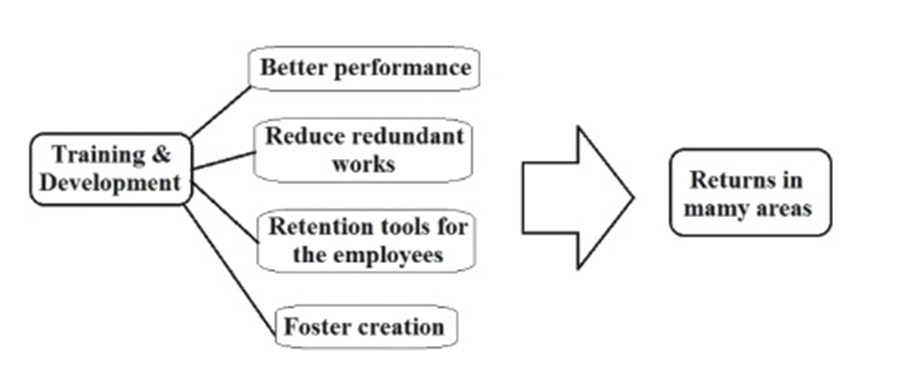
However, despite all the benefits associated with training, there is no point in training just for the sake of training or training everyone in the organization or institution without considering what the organization or institution is trying to achieve, and how training and development programs help in achieving organizational goals. For example, if a hospital found a high rate of infection, it may be considered that infection control training is required for a certain number of selected staff whom training is expected to help in controlling the rate of infection in the hospital. In healthcare organizations training is particularly considered to be an important factor in the reduction of medical errors [1, 2, 3].
HUMAN RESOURCE TRAINING AND DEVELOPMENT
Human resource training and development is an organizational process which aims at advancement of the organization. Proper human resource training and development also facilitate the growth of the organization. If human resource training and development is not professional or suitable; this process will become a bureaucratic system that is a hindrance to the entire employee in the organization.
Human Resource training and development is a process of providing the required knowledge and skills to a human resource professional in the organization. This process has to be continuous and well-planned and organized.
Human resource professionals are very important for the organization, and they need continuous upgrading of their skills and attitudes.
Training help in the fulfillment of the organizational goals. In addition, well-equipped professionals are the means to ensuring optimal performance of all organization's employees.
The input which initiates human resource training and development include new employees, unskilled employees, and potential managers and executives. The output of the process will be motivated and committed newly employed staff, skilled employees, and capable managers and executives.
Human resource training and development involve one of the most important tasks for the organization which is the selection of employees who will become valuable resources. Therefore, human resource training and development should adopt appropriate techniques for selection.
To conduct human Resource training and development in the proper way, the organization should be able in determining the right candidate for every position in the organization.
Some organizations make the selection through an interview panel. The selection interview has to be effective and adhere to the rules of the organization to enable appropriate selection of employees who are planned to become part of the organization [1].
COMPONENTS OF TRAINING AND DEVELOPMENT
Training and development include four main components or activities:
1-Training.
2-Education
3-Learning
4-Development.
Thomas N Garavan (Figure-2A), Pat Costine, and Heraty Noreen (Figure-2B) during their work at the Irish Institute of training and development emphasized that although these components are sometimes considered to be identical, experts in the field generally consider them separate, but interrelated components or activities.


Professional education is an activity that focuses on the job that an individual may potentially hold in the future, and the participants are evaluated against this job. For example, medical education which aims for future job of physician or postgraduate pediatric education of a doctor for the future job of pediatrician respectively.
Learning is a key skill that employee needs to master in the modern medical and healthcare environment because of the continuously changing practices and emergence of a new knowledge.
Training is a process of providing the employees basic skills they need to perform their job or developing new skills. Training is an activity that is focused on, and evaluated against, the job that an individual holds. When doctors are graduated from medical schools, they need a period of training to enable them to perform their duties. In countries, like Iraq, this is called "Rotation residency training".
Table 1 summarizes the main differences between training and learning.
Training | Learning |
More skill based Delivery of knowledge Scheduled in a particular time More practice | More knowledge based Creation and sharing of knowledge Can occur at any time Less practice |
Table 1: The main differences between training and learning
There are generally three domains of the change in a training program (Figure-3).
1-Skills and technical abilities: training is associated with acquisition of skills and enhancement of technical abilities.
2-Behavoural change: training foster positive attitudes and behaviors.
3-Conceptual knowledge: training is associated with gain in conceptual knowledge.
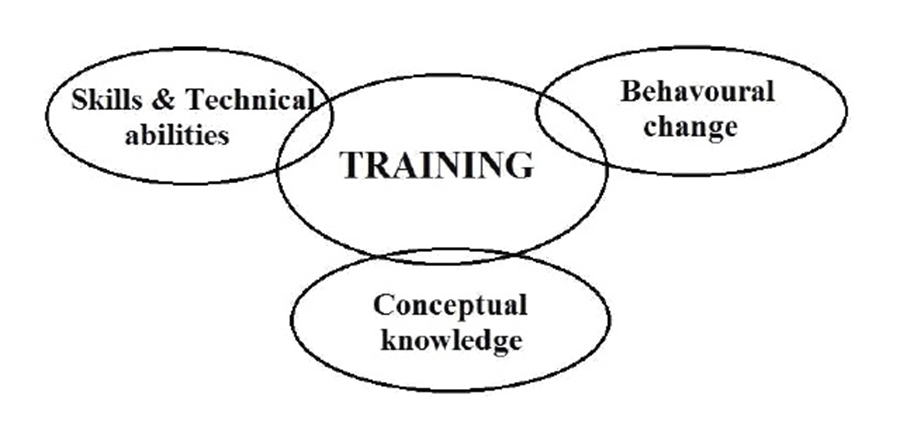
The explosion in knowledge and the advances in technology resulted in a situation demanding that physicians in various fields may need training courses in the emerging applications such as for example stem cell therapies. A consultant surgeon may need training courses in laparoscopic surgery.
Development is an activity that focuses on the activities that individuals in an organization may participate or contribute to in the future. For example, developing a doctor to be a trainer in a certain field by enrolling him or her in a professional training of the trainer course (TOT). Another common example is developing a doctor to be a hospital manager demands enrolling him in a hospital management training course or courses. Therefore, the participants of a development programs generally have a higher position than the participants of a traditional training course.
The explosion in knowledge and the advances in technology resulted in a dire need for the main activities of training and development to be regularly practiced in any organization [1-6]. The activities of training and development help to advance the organization and to achieve the organizational goals as well as the employees' goals through various mechanisms as summarized in table-2.
Table-2: The influences of the activities of professional training and development on the organization |
1-Better utilization of employees. 2-Improvement of the employees' technical and behavioral skills. 3-Help the employees in attaining personal growth. 4-Increase job knowledge and skills of employees at each level. 5-Expand the horizons of human intellect and the overall personality of the employees. 6-Improve the productivity of the employees. 7-Indoctrinate the sense of team work, team spirit, and inter-team. 8-Increase enthusiasm to learn within the employees. 9-Help in creating a learning culture within the organization. 10-Help building the positive perception and feeling about the organization. 11-Improve the quality of work. 12-Help in creating healthy working environment and building good employee, relationship. 13-Help in aligning the employees' goals with organizational goals. 14-Improve the health and safety of the organization. 15-Improve the morale of the employees. 16-Help in creating a better shared image. 17-Improve profitability leads to positive attitudes towards profit orientation. 18-Increase organizational decision making and problem solving. 19-Help in understanding and carrying out organizational policies. 20-Improve leadership skills, motivation, loyalty, better. |
TRAINING AND DEVELOPMENT STAKEHOLDERS
The stakeholders in training and development in general are categorized into several classes as shown in table-3.
Stakeholders | Description |
Sponsors of training and development | Senior managers
|
Clients of training and development | Business planners |
Line managers | People responsible for coaching, resources, and performance |
Participants | People who undergo the processes |
Facilitators | Human resource management staff |
Providers | Specialists in the field |
Table-3: The categories of stakeholders in training and development
Each stakeholder has its own scheme and motivations, which may sometimes conflict with the schemes and motivations of the others. Therefore, training an employee to get along well with authority and with people who entertain diverse points of view is one of the best guarantees of long-term success.
Training programs must support the organization s strategic goals. For example, if one medical organization s goal is to enable employees to have higher certificate in another countries, training the employees in multiple languages can help the achievement of this goals. If a hospital has a goal of attracting patients (clients) from other countries, again training the employees in multiple languages can help the achievement of this goal. Training programs must support performance management.
Performance management is an integrated goal-oriented approach assessing training and rewarding employees' performance. Therefore, training should be used to help employees to meet performance goal [1].
THE TRAINING PROCESS
The stages of training process include:
1-Needs analysis.
2-Setting SMART training objectives.
3-Training program design.
4-Design training methods used during training.
5-Validation of a training course or program by accreditation.
6-Implementation of the training course or program.
7-Evaluation of the training course or program.
NEED ANALYSIS
Need analysis involves identifying training needs for each employee in the organization.
Training need can be identified through:
A-Task analysis: Assessing new employees training needs. Task analysis is performed by a detailed study of a job to identify specific skills required. The minimum skill requirement for each role needs to be determined.
A minimal skill list will enable the establishment a training and development team responsible for building a specific training curriculum.
B-Performance analysis: Assessing current employees training needs.
Methods commonly used in need analysis include:
1-Interviews and feedback from colleagues.
2-Competence or knowledge tests which test job knowledge and skills.
3-Observing work taking place: Observations usually made by supervisor or specialist.
4-Appraisal documents or curriculum vitae.
5-SWOT analysis (Analysis of STRENGTHS, WEAKNESSES, OPPORTUNITIES and THREATS) can be used for identifying the needs of individuals and groups. It is considered a good technique for helping employee to identify their own training needs.
SETTING TRAINING OBJECTIVES
This should be done using the standard management practice of using SMART objectives. Setting SMART objectives is expected to make training evaluation and review much easier. Table-4 summarizes the principles of SMART objectives.
Table-4: SMART objectives | |
S | Specific objectives that explain several tasks |
M | Measurable objectives enable determining tasks completion by measuring the realization of the required targets. |
A | Achievable objectives in term of resources and time. |
R | Realistic objectives at appropriate level and relevant to the development of the employee. |
T | Time-bound objectives with appropriate deadlines scheduled reviewing process. |
TRAINING PROGRAM DESIGN
Designing an effective training program generally involves:
1-Making the learning meaningful. Meaningful materials are easier to understand and remember. Program materials can be made more meaningful by:
A-Providing an overview of the material to be presented at the start of training.
B-Distributing a printed paper summarizing the general ideas and of the training materials.
C-The use of familiar examples.
D-Organizing the presented information logically.
2-Making the skills trained in the course easily transferable to the job site. This can be achieved by:
A-Maximizing the similarities between training environment and work circumstances.
B-Providing a time for adequate practice. People learn better by doing, therefore; it’s important to provide as realistic practice as possible.
3-Motivating the learners through:
A-Defining because training is important and how it will benefit the trainee.
B-Reinforcing immediately correct responses during training.
DESIGN OF TRAINING
Popular training methods include:
1-On job training. This training method is very appropriate for physicians and other health professionals such as nurses during their residency programs.
2-Lectures: lecturing is a commonly used simple method. Figure-4 shows the perceived usefulness and the presumed effectiveness of lecturing to particular training objectives. As shown in the figure, lecturing is most effective in achieving the objective of knowledge acquisition.
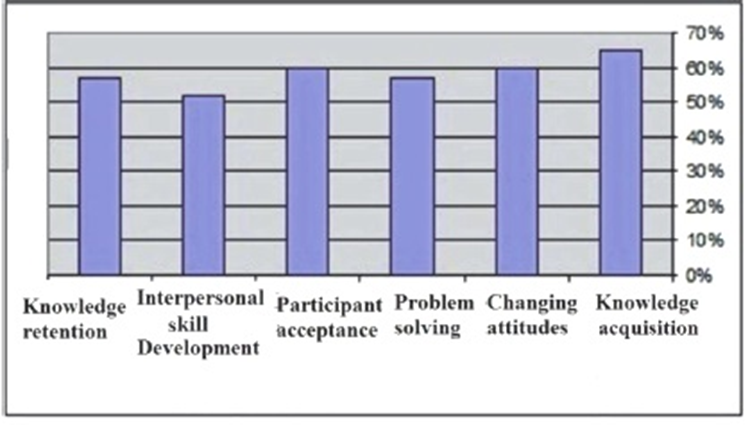
3-Audio-visual training: Training with videos and audiotapes has become increasingly popular. Figure-5 shows the perceived usefulness and presumed effectiveness of training with audio and videotapes to particular training objectives. As shown in the figure, training with video tapes is most effective in achieving the objective of participant acceptance followed by knowledge acquisition. On the other hand, training with audiotapes tapes is most effective in achieving the objective of knowledge acquisition followed by participant acceptance.
4-Case studies
5-Role-Plays
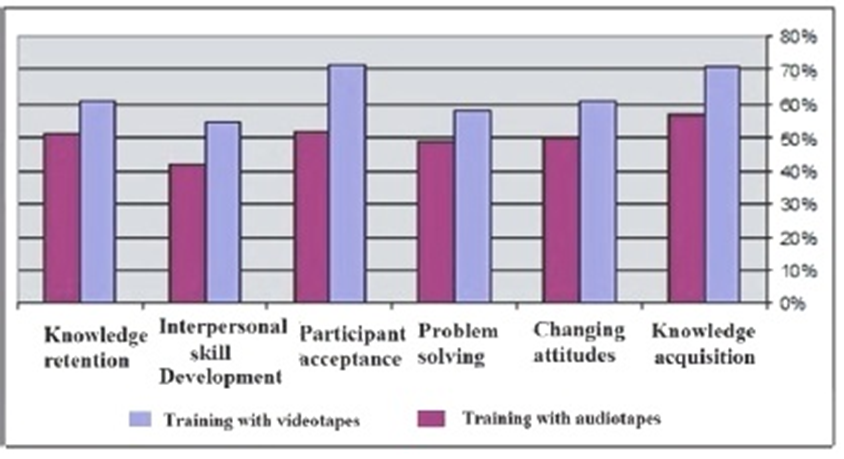
Other training methods include simulated training, distance and online training. Self-assessment, etc.
Each of these popular training methods has advantages and disadvantages. However, depending on the situation each method can be a valuable tool for teaching employees’ new skills and behaviors [1, 2, 3, 7].
VALIDATION OF TRAINING BY ACCREDITATION
Accreditation of a training course occurs when an independent scientific body evaluates a training course; the training methodology used in the course, and the qualifications of the trainers and lecturers of the course, and approves the course.
IMPLEMENTATION OF TRAINING
Train the employees who need to learn the skill. Structure the training into smaller units or modules to lower the chance of fatigue.
EVALUATION OF TRAINING
<!-- /* Font Definitions */ @font-face {font-family:"Cambria Math"; panose-1:2 4 5 3 5 4 6 3 2 4; mso-font-charset:0; mso-generic-font-family:roman; mso-font-pitch:variable; mso-font-signature:-536869121 1107305727 33554432 0 415 0;} @font-face {font-family:Calibri; panose-1:2 15 5 2 2 2 4 3 2 4; mso-font-charset:0; mso-generic-font-family:swiss; mso-font-pitch:variable; mso-font-signature:-469750017 -1073732485 9 0 511 0;} /* Style Definitions */ p.MsoNormal, li.MsoNormal, div.MsoNormal {mso-style-unhide:no; mso-style-qformat:yes; mso-style-parent:""; margin-top:0in; margin-right:0in; margin-bottom:8.0pt; margin-left:0in; line-height:107%; mso-pagination:widow-orphan; font-size:11.0pt; font-family:"Calibri",sans-serif; mso-ascii-font-family:Calibri; mso-ascii-theme-font:minor-latin; mso-fareast-font-family:Calibri; mso-fareast-theme-font:minor-latin; mso-hansi-font-family:Calibri; mso-hansi-theme-font:minor-latin; mso-bidi-font-family:"Times New Roman"; mso-bidi-theme-font:minor-bidi; mso-ansi-language:EN-IN;} .MsoChpDefault {mso-style-type:export-only; mso-default-props:yes; font-family:"Calibri",sans-serif; mso-ascii-font-family:Calibri; mso-ascii-theme-font:minor-latin; mso-fareast-font-family:Calibri; mso-fareast-theme-font:minor-latin; mso-hansi-font-family:Calibri; mso-hansi-theme-font:minor-latin; mso-bidi-font-family:"Times New Roman"; mso-bidi-theme-font:minor-bidi; mso-ansi-language:EN-IN;} .MsoPapDefault {mso-style-type:export-only; margin-bottom:8.0pt; line-height:107%;} @page WordSection1 {size:8.5in 11.0in; margin:1.0in 1.0in 1.0in 1.0in; mso-header-margin:.5in; mso-footer-margin:.5in; mso-paper-source:0;} div.WordSection1 {page:WordSection1;} -->
This important step is commonly disregarded by organization despite spending many resources and time on designing a training program.
The organization must have evidence that training is effective and employees' performance improve as a result of training.
Training in the field of medicine has been increasingly evaluated using Donald Kirkpatrick's four levels of evaluation.
Donald Kirkpatrick (Figure-6) is best known for his doctoral dissertation in 1954 which described a highly influential four levels model for training evaluation. Kirkpatrick's ideas were published in 1959 in several articles in the US Training and Development Journal, and later his ideas were published in 1994 in a book entitled “Evaluating training programs”.
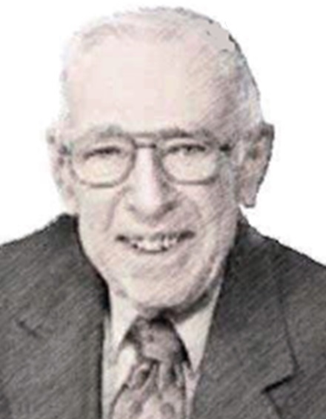
DONALD KIRKPATRICK'S FOUR LEVELS OF EVALUATION
Level 1 evaluation: Reactions
Participants' reactions have an important relation with training and learning. However, a positive reaction does not guarantee learning and successful training, but a negative reaction almost certainly reduces the possibility of significant learning achievement and successful training. This level evaluates how the participants perceived the training, and how they felt about it. Participants' reactions evaluation is generally performed using a feedback form. It is a simple measure of the level satisfaction of the participants:
Did the participants like the training?
Did the participants consider the materials relevant to meaningful?
Level 2 evaluations: Learning
This level evaluates the number of participants’ learning by measuring the acquisition of the content in term of gain in knowledge and skills, and if relevant and possible, the change in attitude. Ideally, learning evaluation is performed formally by conducting a pre- test (before training), and post-test (after training), and comparing the two tests.
Level 3 evaluation: Transfer of learning
This level evaluates if the knowledge, and/or skills learned during training are useable in the practical experience of the learner who is in this setting a medical student or a postgraduate physician. For medical students, this evaluation can be performed during the clinical training sessions. For postgraduate physician, this evaluation level is usually conducted by the clinical supervisor after clinical training by observing the trainees in their workplace.
Level 4 evaluation: Result (outcomes) of training
For medical students, this evaluation can be performed during the clinical examinations following training. For postgraduate physician, this evaluation level is usually involves assessing the success of trainees in making service improvement, and reducing errors in his/her practice [8, 9, 10, 11].
Figure-7 shows the cycle of the training and development process.
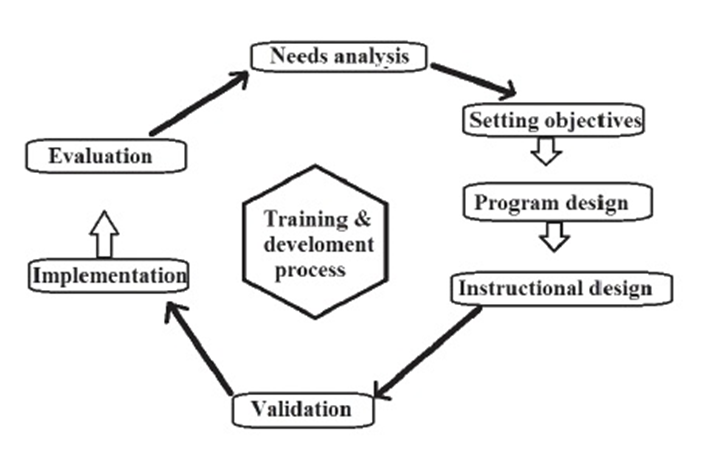
THE PRACTICAL STEPS OF DEVELOPING A TRAINING PROGRAM
Step 1 (Figure-8): Need assessment
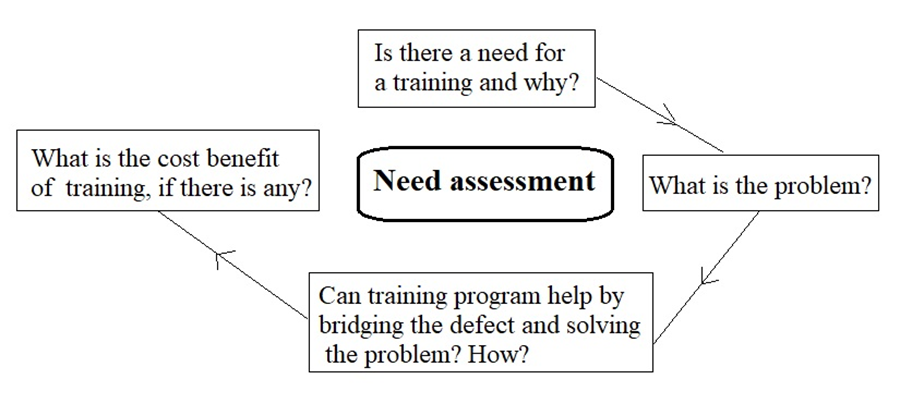
Step 2: Understanding the principles of learning relevant to training
Learning is a self-activity.
Training is considered to be facilitating more than giving learning.
Learners differ in their rate of learning.
Superior learning can be achieved by doing.
Positive reinforcement enhances learning.
Anxiety during training is natural.
Step 3: Understanding the principles of adult learning (Andragogy), VAK/VARK learning model, and major learning theories relevant to training.
Step 4: Understanding of the barriers to training and learning
Trainee personality and comfort zone.
The perception of training as a waste of time.
The lack of practice following a training course.
Lack of training reward and incentives systems.
Step 5: Design training
Setting and stating training objectives in measurable terms is facilitated by understanding Bloom's taxonomy of educational objectives.
Determine the training program content and scientific materials.
Set participants enrolment criteria.
Plan for resources and facilities.
Step 6: Determine training methods
For acquisition of knowledge, use class activities such as lecturing, and
Workshops.
For practical skills, use on job training.
For problem solving, use case studies.
For relational skills, use exercises and games.
For changing behaviors and attitudes, use group techniques
Individual performance, use coaching, etc.
Step 7: Implementing training
Step 8: Training evaluation [1]
ADULT LEARNING (ANDRAGOGY)
Malcolm Shepherd Knowles (Figure-9) was an American educator best known for using the term Andragogy to describe adult learning.
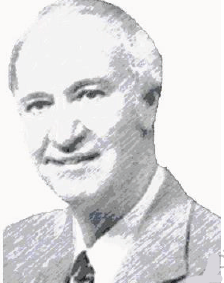
According to Malcolm, Andragogy is the art and science of adult learning and it encompasses all forms of adult learning.
In Greek, andragogy means man-leading. In Greek, pedagogy means child leading.
Pedagogy is a teacher directed approach of instruction.
In 1980, Malcolm suggested four characteristics of adult learners that are different from the characteristics of child learners. In 1984, Malcolm suggested a fifth characteristic (Figure-10):
Self-concept: adults are autonomous and self-directed and need to be respected and treated as self-directed individuals.
Adult learner’s experience: Adults have an accumulated and a growing amount of experience that becomes an important resource for learning.
Readiness to learn: Adults learners are oriented to their social roles, and are goal and relevancy-oriented.
Practical orientation to learning: Adults are practical and want to apply their knowledge. They also have the perspective of immediate application of knowledge rather than the postponed perspective of application of knowledge.
Motivation to learn: Adults have more internal motivation to learn (1984). They need learning to be enjoyable and gives them satisfaction. Adult learners also need to have a choice over what they learn.
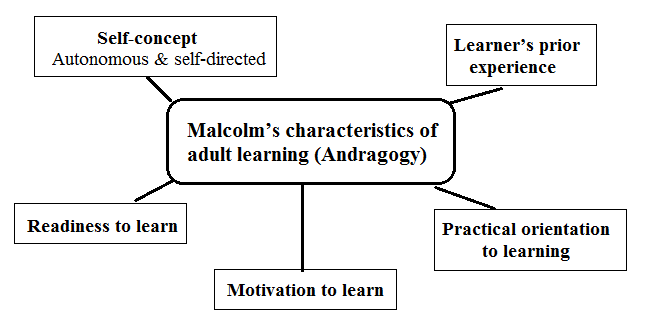
In 1984, the ideas of Malcolm suggested four principles of training:
Adults have to be involved in planning and evaluation of their training. Experience (including mistakes) provides the basis for the learning activities during training.
Adults are most interested in learning subjects that have immediate relevance and impact to their job or personal life.
Adult learning is problem-centered rather than content-oriented.
Malcolm’s ideas practical applications during training
It is important to explain the reasons why specific things are being taught during training.
Training should be more task-oriented instead of memorization.
Training should consider the differences of the learner’ backgrounds, and use various training methods, learning materials and activities.
Adults are self-directed; therefore, training should attempt to make them discover knowledge with guidance and supervision without totally depending on the instructor [8, 9, 12].
VAK/VARK LEARNING MODEL
The VAK model suggests that people vary in their learning orientation, and learners' preferences include visual learning, auditory learning, and kinesthetic learning. Accordingly, instructors have to use various approaches to engage all participants with various learning styles.
Visual learners prefer pictures, diagrams, charts, graphs, flow charts. Therefore, this learning preference is also called “Graphic (G) preference)”.
Auditory learners prefer receiving information by listening. Lecturing and discussions are more effective with such learners.
Kinesthetic learners prefer using experience and practice. Training methods that are more useful for kinesthetic learners include demonstrations, simulations, videos, case studies, and practice.
Many learners are multimodal in their learning preference and have two, or more almost-equal learnin
Neil D. Fleming (Figure-11) added a fourth learning preference which is Read/write (R), and the VARK model emerged (Visual, Aural, Read/write, and Kinesthetic sensory). Fleming introduced the VARK model while working as an inspector for the New Zealand education system.
Fleming thought that some eminent teachers could not reach some students while other less reputed teachers could. Therefore, he introduced the VARK model based on his experiences, and work with students and teachers at Lincoln University.
Read / write preference learners need information to be displayed as words and text-based input and output (reading and writing) in all its forms including PowerPoint, handouts including worksheets, articles, and assignments [10,11.13].
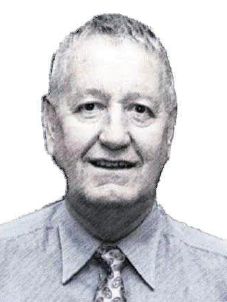
MAJOR LEARNING THEORIES RELEVANT TO TRAINING
Learning is a change in mental association and behavior due to certain experience. There are several theories of learning including theories of behaviorism, constructivism and cognitivism. Understanding learning theories enables the trainer to develop multiple perspectives into training. Therefore, learning theories are like multiple windows in a house that enables looking into the same room to get different viewpoints from each window.
Cognitivism (Cognitive learning theory)
Cognitive learning occurs through the acquisition of knowledge and skills by mental or cognitive processes and information processing. In cognitive learning, the learner learns by listening, watching, reading, or experiencing and then processing and remembering the information.
Cognitivism is a learning theory focusing on how information received, organized, stored and retrieved by the mind. Cognitivism views the mind as an information processor. Accordingly, training should focus on achieving three goals:
1-Understanding
2-Retention
3-Recalling
Cognitivism emphasizes that better retention and recall of information can be achieved through the use of a well-organized and sequenced training processes, and presenting the information in a consequential and easily understandable way. Better understanding can be achieved by activating prior knowledge by beginning training by a review quiz and arranging the information into comprehensible parts, and using graphics. Retention of information can be improved with use of visual aids and mnemonics like SMART objectives (Specific, Measurable, Achievable, Relevant, and Time-bound). Cognitivism emphasizes that learning involves recall of stored information, and learning occurs when the learner can recall stored information.
Behaviorism learning theory
Behaviorism theory focus on behavior instead of thought during training and suggests making behavior changes in the learner by repetition and reinforcement with focusing on what the instructor wants the participants to do. However, for a beginner (e.g., a medical student), focusing on the gains in knowledge (Cognitive approach) is necessary, and it is more important to be able to describe how to perform the procedure than actually be able to do it. Therefore, it would be better to think of both approaches when planning training.
Constructivism theory
Constructivism theory emphasizes that using learners’ prior knowledge as the starting point for new learning can be associated with more effective learning. It focuses on the inner thoughts of learners, and how they actively construct knowledge out of experiences, and thus it suggests that training have to make learners actively involved in the process of knowledge construction as possible rather than just receiving information. Learning is best achieved by guiding problem solving. Therefore, constructivist training encourages critical thinking, and creates motivated and independent learners that can build knowledge by doing or practicing [10, 11.14].
Figure-12 summarizes the major learning theories relevant to training.
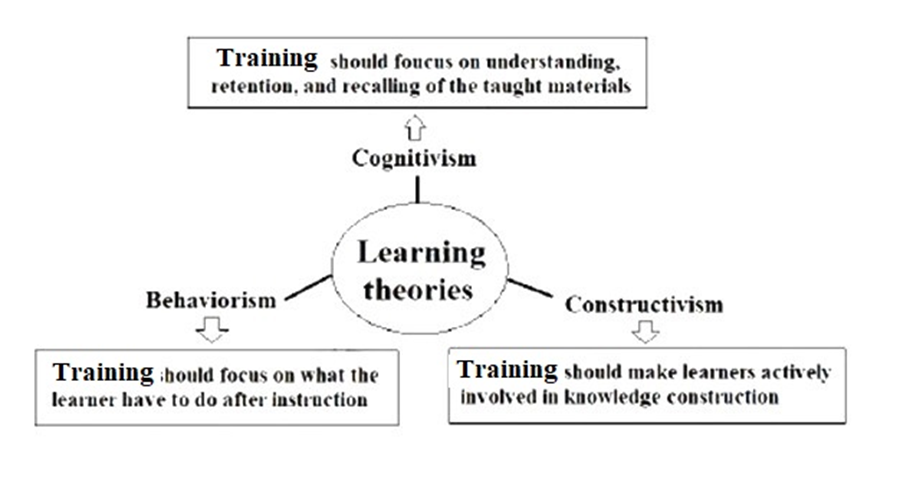
BLOOM'S TAXONOMY
The cognitive domain of learning and training has been the primary focus of the majority of traditional training methods.
It is frequently used to structure curriculum learning objectives, assessments and activities. It was originally suggested by Benjamin Bloom (Figure-13), who was the chair of the committee of educators who proposed taxonomy of educational objectives based on the classification of educational goals.

They published the first volume of the standard taxonomy of educational objectives. The taxonomy aimed at promoting higher thinking in education such as analyzing and evaluating.
In 1956, Bloom edited the first volume of “Taxonomy of educational objectives: the classification of educational goal”. The publication described a classification of learning objectives (Bloom's taxonomy) which became an important tool for developing training and educational curriculum.
In the original version of Bloom’s taxonomy, the cognitive domain classified thinking and learning into six levels with six levels of objectives that can be practically used to create learning objectives for training.
In the 2001 revised edition of Bloom's taxonomy, the levels were a little different and included remembering, understanding or comprehending, applying, analyzing, evaluating, and creating rather than synthesizing.
Remembering involves retrieving, recognizing, and recalling knowledge (facts, terms, and basic concepts) for long term memory without necessarily understanding their meaning. Remembering is necessary inacquiring knowledge of specifics such and knowledge of classifications and categories.
Understanding or comprehending involves constructing meaning of facts and ideas from oral, written, and graphic messages. Understanding can be shown by the ability to interpret, explain, infer, compare, and summarize by organizing the main ideas.
Applying the learnt knowledge (facts, techniques and rules) to perform or conduct something.
Analyzing information by dividing it into parts, and determining how the parts are related, and identifying causes, and making inferences and finding evidence to support generalizations.
Evaluating involves:
Making judgments based on criteria and standards.
Presenting views and opinions, and supporting them by information. Evaluating the validity of ideas, or quality of work based on a set of criteria.
Synthesizing or creating a structure or pattern from diverse elements by putting parts together to form a whole. Synthesizing involves making a unique message or statement and making a plan.
The six cognitive levels are generally hierarchical and begin with lower order thinking skills to higher order thinking skills.
Learning on higher levels generally demands gaining prerequisite knowledge and skills at lower levels. Bloom's taxonomy can be used as backbone of training materials, and can also be used for organizing the taught knowledge and skills. Bloom's taxonomy can also be used as a tool to design questions for the exams and assignments.
According to the taxonomy:
The participant needs to remember the concept before being able to understand it (Figure-14).
The participant needs to understand the concept before being able to apply it. The participant needs to analyze the concept before being able to evaluate it.
The participant needs to thoroughly evaluate a concept before being able to create an accurate conclusion or using it in performing something.
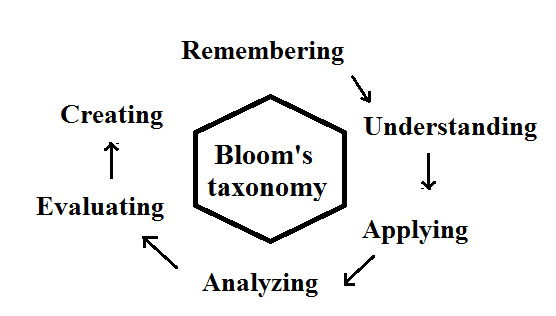
When introducing a new concept, the participants need to remember, understand, and apply the concept before moving to the higher order skills such analyzing, evaluating, and creating. The cognitive domain levels help the instructor to write measurable and observable learning objective statement to describe what the participants will be able to do at the end of training unit or module.
Figure-15 shows the educational objectives at each level of Bloom's Taxonomy and the relevant educational goals [10, 11, 15].
TRAINING METHODS
LECTURING
Lecturing or explaining is one of the most popular training methods. During a traditional lecture, the instructor usually talks and the participants listen with or without taking notes. Lecturing is the process of training by giving spoken explanations of the subject to be learned. Lecturing is often accompanied by visual aids to facilitate learning.
Advantage: Learning materials can be covered easily and quickly.
Disadvantages: Learning can be associated with lack of interaction and high likelihood of boredom.
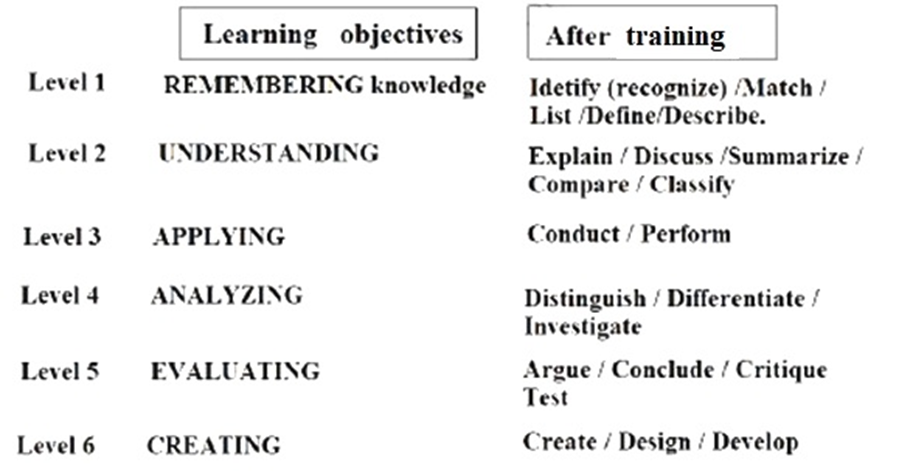
Lecturing: The misconception
It is pity to observe many who lack the experience of lecturing, make a lecture by copying texts from books or other sources converting this training method of lecturing into something more like a book reading. Many experts suggested that instead of reading a text brought from books, articles and other sources, it will be more convenient and time saving to ask the audience to read the chosen text or article. Therefore, in order to avoid the unnecessary practice of book or article reading instead of lecturing, a lecture should include at least 10 references. For lectures in the field of applied sciences like medicine, at least seven of the references should be scientific journal articles, and the use of books as a reference is preferably limited to three or less.
Preparing a lecture
Organizing the ideas of a lecture by selecting a title that conveys clearly what the lecture is all about, and giving an overview about the topics of the lecture with a concise overview of the new information presented during the lecture.
Relating new content to prior knowledge.
Organizing and elaborating new information.
Reducing boredom by asking questions, inviting questions and allowing discussion.
Effective lecturing during training demands adequate preparation before lecturing and keeping the attendance with the instructor through adequate eye contact as possible, speaking clearly, and involving the participants thorough encouraging questions.
Effective lecturing during training also demands keeping the attendance focused on the presented materials by presenting the topics and materials in a logical sequence, bridging each topic to the next, and by the use of visual aids.
ROLE-PLAY
Appropriately using role-playing during training can help in the achievement of effective learning through making the participants practice skills they have acquired, and demonstrating their knowledge and understanding of training materials.
In clinical sessions, medical students play their future role as doctors, and learn how to take history and perform a physical examination. This method is also appropriate in teaching students of medicine and postgraduate physicians counseling skills, and it can be used in clinical sessions and consultation clinics, where the consultant allow the trainees to play their future role as a consultant and provide counseling.
TRAINING WITH CASE STUDIES
In the field of medicine, case studies used during training should be real cases and supplemented by questions that help in understanding and expanding to the relevant knowledge.
Case studies improve retention, recall, and application of knowledge in real practice situations, and gaining the experience with the diagnosis and management of conditions that have not been encountered by the students or trainee.
It has been disturbingly observed that many learners in the field of medicine, both undergraduate and postgraduate, may have satisfactory information acquisition in their fields of study, but fail to use it appropriately when it comes to clinical practice. Training with case studies has been used to encourage learners to adopt deep learning approaches and enhance understanding which help in establishing and creating experience.
DEMONSTRATION
Demonstration as a method of training is generally practiced by showing how to do it, for example how to reach a clinical diagnosis. It is based on making impersonal experiences of memorization become like a personal experience. It helps to raise participants’ interest and reinforce memory retention because they provide connections between facts and real applications of those facts. For example, when teaching how to reach a diagnosis of a clinical problem through considering various differential diagnoses and excluding the less relevant diagnoses.
DISCUSSION
This training method is generally more suitable for postgraduate physicians. It is an active learning process by talking with each other and listening to other points of view.
In this training method, the trainer describes briefly a topic or problem and invites participants to comment. One of the advantages of this method is enabling the trainer to judge the interest of the participants in the topic and the opportunity to stimulate interest. However, discussions may not cover all the points intended to be covered and dominant participants may take over and do not allow hesitant participants to speak.
BRAINSTORMING
Brainstorming is a training method that is suitable for postgraduate physicians. It is generally aiming at stimulating participants’ creativity to help them in finding possible solutions for a specific problem.
It is initiated by presenting a main statement which defines clearly the problem, and asking participants to feel free to offer any solution that can help in identifying the roots of the problem, and thus facilitating a solution.
At the beginning, all the spontaneous new ideas are taken and listed without allowing criticism. Thereafter, the ideas are evaluated with aim of taking the more logical and practical suggestions.
Brain storming method was first suggested by Alex Faickney Osborn (Figure-16A) in his book “Applied Imagination, Principles and Procedures of creative thinking” (Figure-16B).
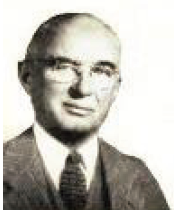
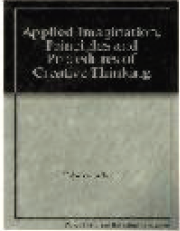
Alex Osborn used four general rules to practice brainstorming with aim of reducing social inhibitions among the participants, stimulating idea generation, and enhancing overall creativity of the participants.
1-An initial emphasis on quantity to facilitate the emergence of a solution for the presented problem. The more the generated ideas the higher the chance of finding an effective solution.
2-An initial withholding of criticism to encourage the participants to focus on increasing the number of ideas. Therefore, during the early stage, judgment is suspended to make the participants feel free to generate unusual ideas that may prove later to be useful.
3-Welcoming wild ideas to obtain a satisfactorily long list of suggestions, and allowing the emergence of new perspectives which may lead to better solutions.
4-Combining ideas and improving them. Alex Osborn suggested beginning the method by asking one specific question and not multiple questions. The question should aim at defining and solving a problem that requires the generation of ideas rather than judgment [2, 3, 9, 10, 16].
Figure-17 shows the popular training methods.
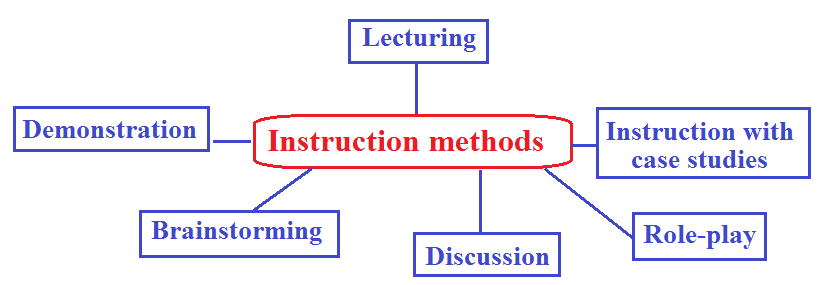
TRAINING EVALUATION
Raining evaluation is a continuous and systematic process of assessing the value or potential value of a training course, activity or event. When designing a training program, it is mandatory to consider the consequent need for evaluation. Therefore, training program should be designed against specific objectives and expected benefits. This design will enable evaluation of the successfulness of a training course against certain achievement indicators. Therefore, evaluation models are designed to make the progress of the training program clearly reflected through the periodical evaluations.
Evaluation results and reports are used to determine and integrate the necessary improvements or modifications in the training courses during the succeeding phases. In fact, Evaluation results and reports are used as a guide to decision-making around various components of the training (e.g., instructional design, delivery, results) and its overall continuation, modification, or elimination.
A training program evaluation examines achievement of program objectives in the context of other aspects of program performance or in the context in which it occurs.
A program assessment begins by asking questions about every aspect of the program which including:
1-Inputs: Resources used to create the program.
2-Outcomes (program results).
A program may have activities in addition to training (e.g., services, meetings). In such cases, training evaluation data can be used in the overall program evaluation.
Organizations need to evaluate their training programs annually to determine to what extent these plans and programs contributed to mission accomplishment and meeting organizational performance goals.
Demands to demonstrate training program efficiency effectiveness are increasing. Table-5 summarizes the steps of training course or program evaluation [1, 2, 3, 17].
Table-5: The steps of training course or program evaluation |
1-Examine the assumptions upon which an existing or proposed training course or program is based. 2-Examine the expected results of proposed training course or program and collect information about inputs and outcomes of an existing course or program. 3-Determine the achievement of objectives. 4-Identify strengths and weaknesses of a program/course. 5-Determine the cost-effectiveness of a program/course. 6-Assess causes of success or failure. 7-Report findings and the analysis of course/program effectiveness or quality in a manner that facilitates their use. 8-Use evaluation data: A-In planning to assess needs, to set priorities, to direct allocation of resources, to guide policy. B-In guiding decision-making to improve effectiveness, to identify and facilitate needed change., and to continue in expanding or terminating a program/course. C-In maintaining accountability to stakeholders, to funding sources, and to the general public.
|
TRAINING EVALUATION MODELS
Evaluation involves assessing the strengths and weaknesses of programs, policies, personnel, products, and organizations to improve their effectiveness.
Kirkpatrick four Levels are generally used for evaluation of learning during training.
Jack Phillips suggested using a fifth level of the Return on Investment (ROI) produced by a training course using the financial formula: ROI (%) = Net program benefits divided by the program costs and multiplied by 100.
Robert Brinkerhoff suggested the use of six stages model (The case success method) for the comprehensive evaluation of training. It incorporates the results aspects and the formative, improvement aspects of educational models. A basic assumption of the six-stage model is that the primary reason for evaluation should be to improve the program [1].
Acknowledgement
Some of the figures in this paper were included in previous author's publication, but the author has their copyrights.
Conflict of interest: None.
References
- Al-Mosawi AJ. Principles of training and development for physicians .1st ed., Saarbrücken; LAP Lambert Academic Publishing: 2014 (ISBN: 978-3-659-53092-0). Doi:10.13140/rg.2.1.1173.4803
- Al-Mosawi AJ. An accredited training of the trainers (TOT) training course. 1st ed., Saarbrücken; LAP Lambert Academic Publishing: 2017 (ISBN: 978-3-659-88198-5).
- Al-Mosawi AJ. Training of the trainers (TOT) course book. Scholars' Press, May 2021 (ISBN: 978-613-8-95332-6).
- Al-Mosawi AJ. Essential training knowledge for physicians working in the field of professional training and development, and medical schools’ instruction. Research and Reviews on Healthcare: Open Access Journal (ISSN: 2637-6679) 2019 November 25; 4; 3: 347-367.Doi: 10.32474/RRHOAJ.2019.04.000187
- Al-Mosawi AJ. Training knowledge for physicians and medical schools’ instructors.1st ed., Saarbrücken; LAP Lambert Academic Publishing: 2020 (ISBN: 978-620-2-67481-2).
- Al-Mosawi AJ.Ausbildungswissen für Ärzte und Ausbilder von medizinischen Schulen (German Edition).Verlag Unser Wissen:2020 (ISBN-10: 6202628405, ISBN-13: 978-6202628402).
- Al-Mosawi AJ.Formação de conhecimentos para médicos e instrutores das escolas médicas (Portuguese Edition) Edições Nosso Conhecimento :2020 (ISBN-10: 6202628464 , ISBN-13: 978-6202628464).
- Al-Mosawi AJ. Modern Instruction in Medicine: A Practical Course. Scholars' Press, Oct 2021 (ISBN-13:978-613-8-96233-5, ISBN-10: 6138962338).
- Al-Mosawi AJ. Atlas of Down syndrome in Iraqi children. Scholars' Press, Nov 19, 2021 (ISBN-13: 978-613-8-96521-3, ISBN-10:6138965213).
- Al-Mosawi AJ. Principles of instruction for board certified physicians: An accredited course. LAP LAMBERT Academic Publishing: December, 2021 (ISBN: 978-620-4-72764-6).
- Al-Mosawi AJ. Essentials of instruction methods for board certified physicians: An accredited course. Scholars' Press, Nov, 2021(ISBN: 978-613-8-96565-7).
- Al-Mosawi AJ. Wiedza szkoleniowa dla lekarzy i instruktorów szkół medycznych (Polish Edition).Wydawnictwo Nasza Wiedza :2020 (ISBN-10: 6202628456 , ISBN-13: 978-6202628457)
- Al-Mosawi AJ. Opleidingskennis voor artsen en instructeurs van medische scholen (Dutch Edition). Uitgeverij Onze Kennis: 2020 ISBN-10: 6202628448 , ISBN-13: 978-6202628440).
- Al-Mosawi AJ. Formazione dei medici e degli istruttori delle scuole di medicina (Italian edition). Edizioni Sapienza : 2020-07-14 (ISBN-13: 978-620-2-62843-3, ISBN-10:620262843X).
- Al-Mosawi AJ. Conocimientos de capacitación para médicos e instructores de escuelas de medicina (Spanish edition).Ediciones Nuestro Conocimiento: (ISBN-13:978-620-2-62841-9, ISBN-10:6202628413).
- Al-Mosawi AJ. Formation des connaissances des médecins et des instructeurs des écoles de medicine (French edition). Editions Notre Savoir: 2020 (ISBN-13:978-620-2-62842-6, ISBN-10:6202628421).
- Al-Mosawi AJ. Обучающие знания для врачей и инструкторов медицинских вузов (Russian edition). Scientia Scripts: 2020 (ISBN-13: 978-620-2-62847-1, ISBN-10: 6202628472).
Quick links
- Abstract
- TRAINING AND DEVELOPMENT: AN OVERVIEW
- HUMAN RESOURCE TRAINING AND DEVELOPMENT
- COMPONENTS OF TRAINING AND DEVELOPMENT
- TRAINING AND DEVELOPMENT STAKEHOLDERS
- THE TRAINING PROCESS
- NEED ANALYSIS
- Training need can be identified through:
- Methods commonly used in need analysis include:
- SETTING TRAINING OBJECTIVES
- TRAINING PROGRAM DESIGN
- DESIGN OF TRAINING
- VALIDATION OF TRAINING BY ACCREDITATION
- IMPLEMENTATION OF TRAINING
- EVALUATION OF TRAINING
- DONALD KIRKPATRICK'S FOUR LEVELS OF EVALUATION
- ADULT LEARNING (ANDRAGOGY)
- VAK/VARK LEARNING MODEL
- Many learners are multimodal in their learning preference and have two, or more almost-equal learnin
- MAJOR LEARNING THEORIES RELEVANT TO TRAINING
- Cognitivism (Cognitive learning theory)
- Behaviorism learning theory
- Constructivism theory
- BLOOM'S TAXONOMY
- Evaluating involves:
- According to the taxonomy:
- TRAINING METHODS
- ROLE-PLAY
- TRAINING WITH CASE STUDIES
- DEMONSTRATION
- DISCUSSION
- BRAINSTORMING
- TRAINING EVALUATION
- TRAINING EVALUATION MODELS
- Acknowledgement
- References


